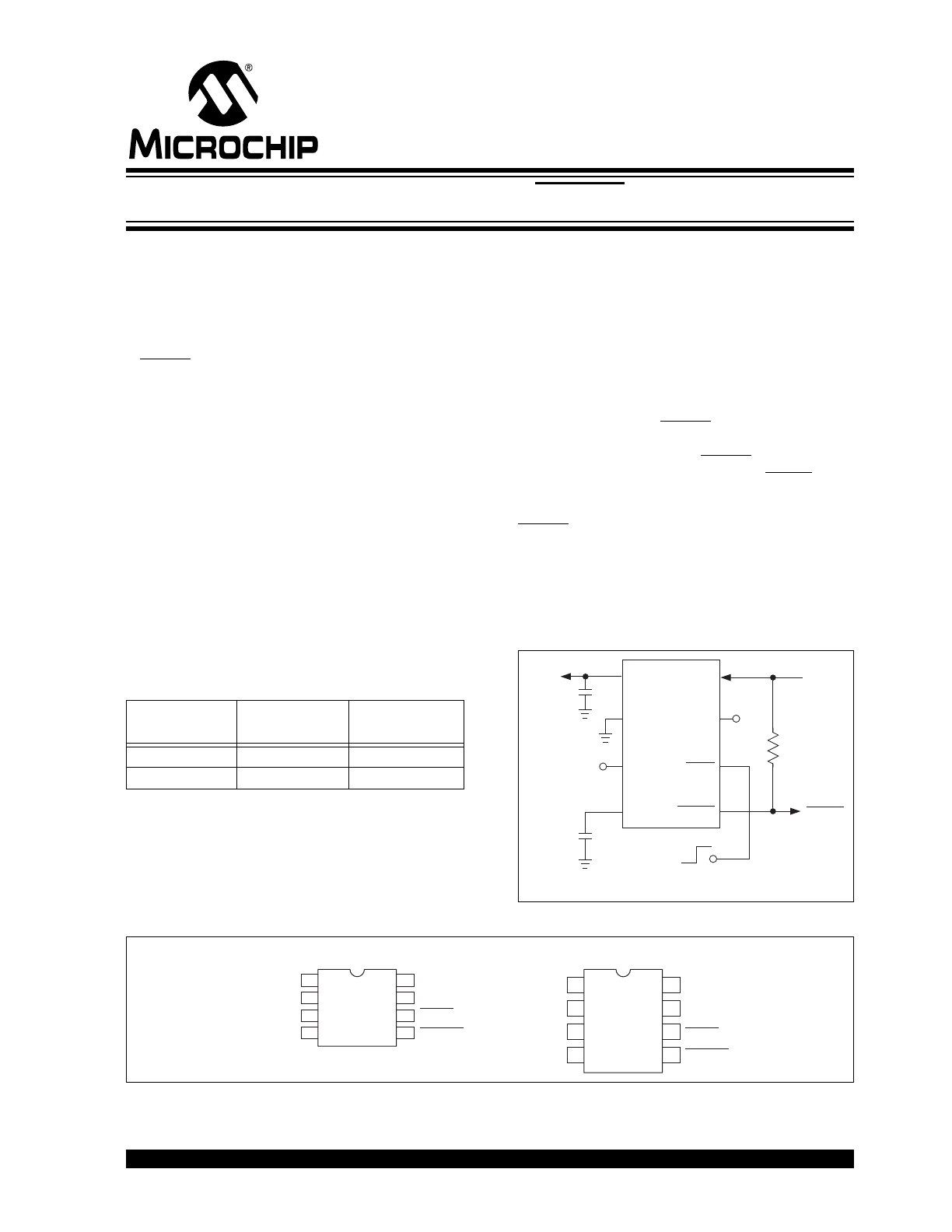
2002-2012 Microchip Technology Inc.
DS21362C-page 1
TC1173
Features
• Extremely Low Supply Current for Longer Battery Life
• Very Low Dropout Voltage
• 300mA Output Current
• Standard or Custom Output Voltages
• ERROR Output Can Be Used as a Low Battery
Detector or Processor Reset Generator
• Power Saving Shutdown Mode
• Bypass Input for Ultra Quiet Operation
• Over Current and Over Temperature Protection
• Space-Saving MSOP Package Option
Applications
• Battery Operated Systems
• Portable Computers
• Medical Instruments
• Instrumentation
• Cellular/GSM/PHS Phones
• Linear Post-Regulators for SMPS
• Pagers
Device Selection Table
NOTE: xx indicates output voltages
Available Output Voltages: 2.5, 2.8, 3.0, 3.3, 5.0.
Other output voltages are available. Please contact Microchip
Technology Inc. for details.
General Description
The TC1173 is a precision output (typically ±0.5%)
CMOS low dropout regulator. Total supply current is
typically 50
A at full load (20 to 60 times lower than in
bipolar regulators).
TC1173 key features include ultra low noise operation
(plus optional Bypass input); very low dropout voltage
(typically 240mV at full load) and internal feed-forward
compensation for fast response to step changes in
load. An error output (ERROR) is asserted when the
TC1173 is out-of-regulation (due to a low input voltage
or excessive output current). ERROR can be set as a
low battery warning or as a processor RESET signal
(with the addition of an external RC network). Supply
current is reduced to 0.05
A (typical) and V
OUT
and
ERROR fall to zero when the shutdown input is low.
The TC1173 incorporates both over temperature and
over current protection. The TC1173 is stable with an
output capacitor of only 1
F and has a maximum
output current of 300mA.
Typical Application
Package Type
Part Number
Package
Junction
Temp. Range
TC1173-xxVOA
8-Pin SOIC
-40°C to +125°C
TC1173-xxVUA
8-Pin MSOP
-40°C to +125°C
TC1173
1
2
3
4
5
6
7
8
V
OUT
V
OUT
C
BYPASS
470pF
(Optional)
Shutdown Control
(from Power Control Logic)
C1
1
μF
GND
NC
Bypass
V
IN
V
IN
NC
SHDN
+
ERROR
R3
1M
ERROR
8-Pin SOIC
1
2
3
4
V
IN
5
6
7
8
NC
V
OUT
GND
NC
Bypass
TC1173VOA
8-Pin MSOP
1
2
3
4
V
IN
5
6
7
8
NC
V
OUT
GND
NC
Bypass
SHDN
TC1173VUA
ERROR
SHDN
ERROR
300mA CMOS LDO with Shutdown ERROR Output and Bypass
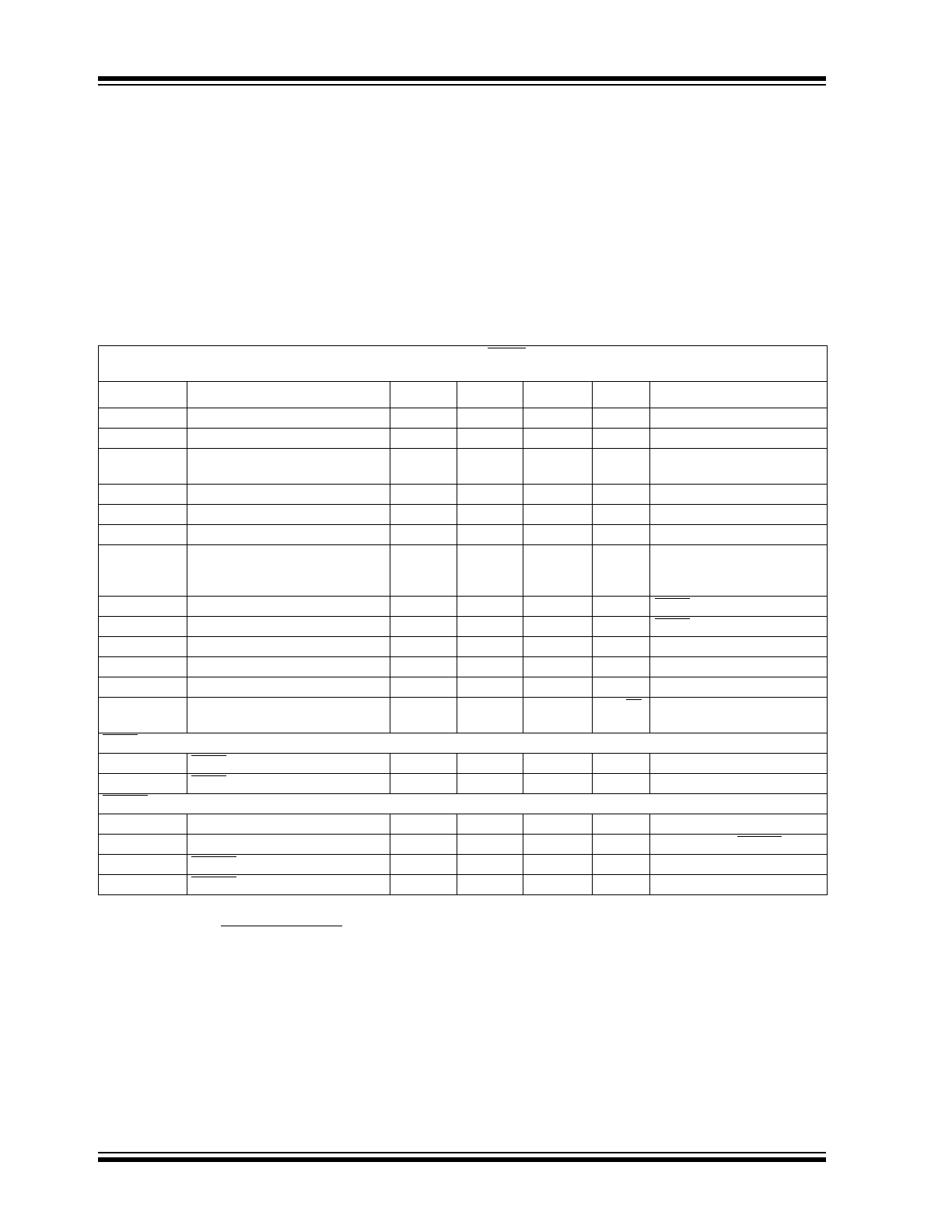
TC1173
DS21362C-page 2
2002-2012 Microchip Technology Inc.
1.0
ELECTRICAL
CHARACTERISTICS
Absolute Maximum Ratings*
Input Voltage .........................................................6.5V
Output Voltage.................. (V
SS
– 0.3V) to (V
IN
+ 0.3V)
Power Dissipation................Internally Limited (Note 6)
Maximum Voltage on Any Pin ........ V
IN
+0.3V to -0.3V
Operating Temperature Range...... -40°C < T
J
< 125°C
Storage Temperature..........................-65°C to +150°C
Stresses above those listed under "Absolute Maximum
Ratings" may cause permanent damage to the device. These
are stress ratings only and functional operation of the device
at these or any other conditions above those indicated in the
operation sections of the specifications is not implied.
Exposure to Absolute Maximum Rating conditions for
extended periods may affect device reliability.
TC1173 ELECTRICAL SPECIFICATIONS
Electrical Characteristics: V
IN
= V
OUT
+ 1V, I
L
= 0.1mA, C
L
= 3.3
F, SHDN > V
IH
, T
A
= 25°C, unless otherwise noted. Boldface
type specifications apply for junction temperatures of -40°C to +125°C.
Symbol
Parameter
Min
Typ
Max
Units
Test Conditions
V
IN
Input Operating Voltage
2.7
—
6.0
V
Note 8
I
OUT
MAX
Maximum Output Current
300
—
—
mA
V
OUT
Output Voltage
—
V
R
– 2.5%
V
R
±0.5%
—
—
V
R
+ 2.5%
V
Note 1
V
OUT
/
T
V
OUT
Temperature Coefficient
—
40
—
ppm/°C
Note 2
V
OUT
/
V
IN
Line Regulation
—
0.05
0.35
%
(V
R
+ 1V)
V
IN
6V
V
OUT
/V
OUT
Load Regulation
—
0.5
2.0
%
I
L
= 0.1mA to I
OUT
MAX
(Note 3)
V
IN
-V
OUT
Dropout Voltage
—
—
—
20
80
240
30
160
480
mV
I
L
= 0.1mA
I
L
= 100mA
I
L
= 300mA (Note 4)
I
SS1
Supply Current
—
50
90
A
SHDN = V
IH,
I
SS2
Shutdown Supply Current
—
0.05
0.5
A
SHDN = 0V
PSRR
Power Supply Rejection Ratio
—
60
—
dB
F
RE
1kHz
I
OUT
SC
Output Short Circuit Current
—
550
650
mA
V
OUT
= 0V
V
OUT
/
P
D
Thermal Regulation
—
0.04
—
V/W
Note 5
eN
Output Noise
—
260
—
nV/
Hz F = 1kHz, C
OUT
= 1
F,
R
LOAD
= 50
SHDN Input
V
IH
SHDN Input High Threshold
45
—
—
%V
IN
V
IL
SHDN Input Low Threshold
—
—
15
%V
IN
ERROR Output
V
MIN
Minimum Operating Voltage
1.0
—
—
V
V
OL
Output Logic Low Voltage
—
—
400
mV
1 mA Flows to ERROR
V
TH
ERROR Threshold Voltage
—
0.95 x V
R
—
V
V
OL
ERROR Positive Hysteresis
—
50
—
mV
Note 7
Note
1:
V
R
is the user-programmed regulator output voltage setting.
2:
3:
Regulation is measured at a constant junction temperature using low duty cycle pulse testing. Load regulation is tested over a load range
from 0.1mA to the maximum specified output current. Changes in output voltage due to heating effects are covered by the thermal regula-
tion specification.
4:
Dropout voltage is defined as the input to output differential at which the output voltage drops 2% below its nominal value measured at a
1V differential.
5:
Thermal Regulation is defined as the change in output voltage at a time T after a change in power dissipation is applied, excluding load or
line regulation effects. Specifications are for a current pulse equal to I
L
MAX
at V
IN
= 6V for T = 10 msec.
6:
The maximum allowable power dissipation is a function of ambient temperature, the maximum allowable junction temperature and the
thermal resistance from junction-to-air (i.e., T
A
, T
J
,
JA
). Exceeding the maximum allowable power dissipation causes the device to initiate
thermal shutdown. Please see Section 4.0 Thermal Considerations for more details.
7:
Hysteresis voltage is referenced by V
R
.
8:
The minimum V
IN
has to justify the conditions: V
IN
V
R
+ V
DROPOUT
and V
IN
2.7V for I
L
= 0.1mA to I
OUT
MAX
.
TC V
OUT
= (V
OUT
MAX
– V
OUT
MIN
) x 10
6
V
OUT
x
T

2002-2012 Microchip Technology Inc.
DS21362C-page 3
TC1173
2.0
PIN DESCRIPTIONS
The descriptions of the pins are listed in Table 2-1.
TABLE 2-1:
PIN FUNCTION TABLE
Pin No.
(8-Pin SOIC)
(8-Pin MSOP)
Symbol
Description
1
V
OUT
Regulated voltage output.
2
GND
Ground terminal.
3
NC
No connect.
4
Bypass
Reference bypass input. Connecting a 470pF to this input further reduces output noise.
5
ERROR
Out-of-Regulation Flag. (Open drain output). This output goes low when V
OUT
is out-of-tolerance
by approximately – 5%.
6
SHDN
Shutdown control input. The regulator is fully enabled when a logic high is applied to this input.
The regulator enters shutdown when a logic low is applied to this input. During shutdown, output
voltage falls to zero and supply current is reduced to 0.05
A (typical).
7
NC
No connect.
8
V
IN
Unregulated supply input.
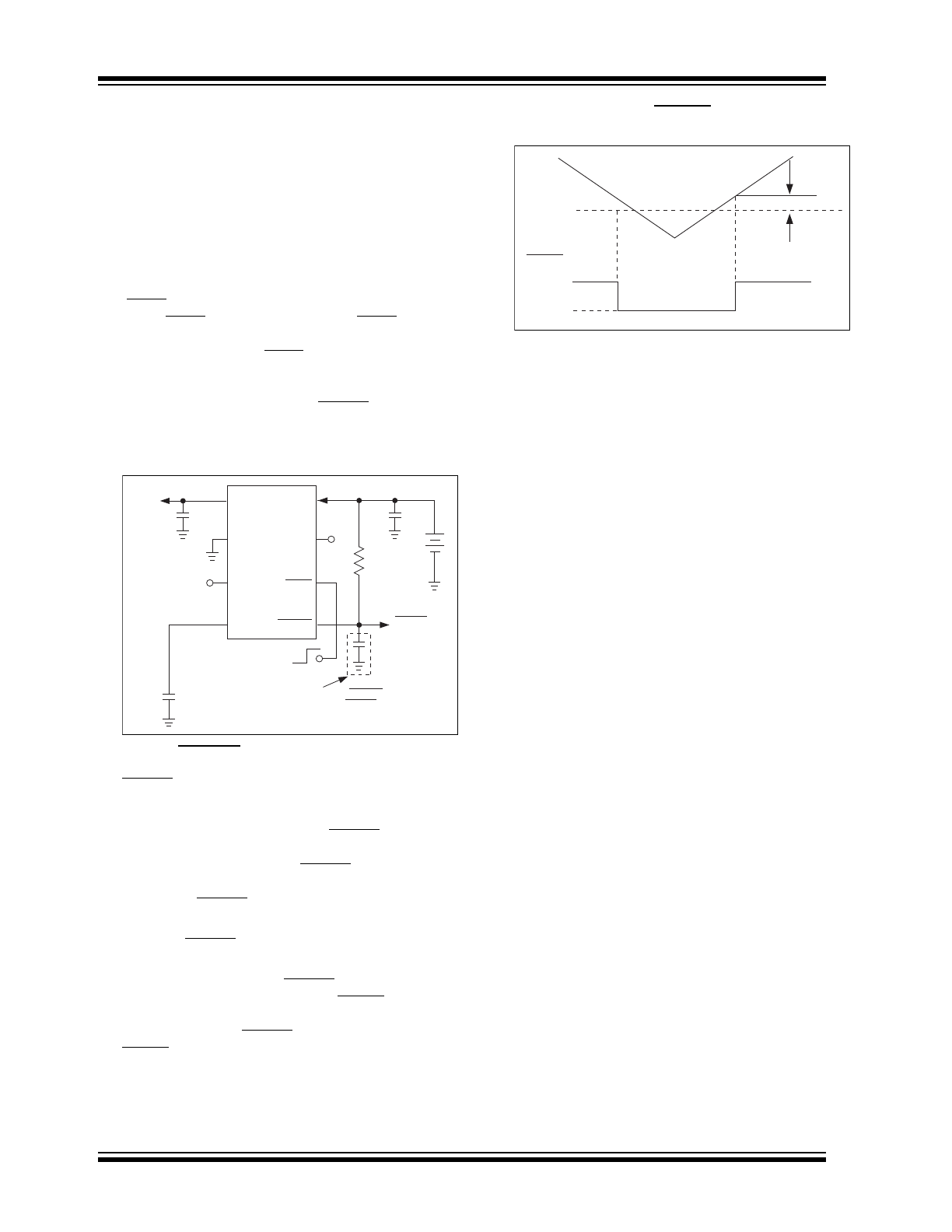
TC1173
DS21362C-page 4
2002-2012 Microchip Technology Inc.
3.0
DETAILED DESCRIPTION
The TC1173 is a fixed output, low drop-out regulator.
Unlike bipolar regulators, the TC1173’s supply current
does not increase with load current. In addition, V
OUT
remains stable and within regulation over the entire
0mA to I
OUT
MAX
operating load current range, (an
important consideration in RTC and CMOS RAM
battery back-up applications).
Figure 3-1 shows a typical application circuit. The
regulator is enabled any time the shutdown input
(SHDN) is at or above V
IH
, and shutdown (disabled)
when SHDN is at or below V
IL
. SHDN may be
controlled by a CMOS logic gate, or I/O port of a
microcontroller. If the SHDN input is not required, it
should be connected directly to the input supply. While
in shutdown, supply current decreases to 0.05
A
(typical), V
OUT
falls to zero and ERROR is disabled.
FIGURE 3-1:
TYPICAL APPLICATION
CIRCUIT
3.1
ERROR Output
ERROR is driven low whenever V
OUT
falls out of
regulation by more than – 5% (typical). This condition
may be caused by low input voltage, output current
limiting, or thermal limiting. The ERROR threshold is
5% below rated V
OUT
regardless of the programmed
output voltage value (e.g., ERROR = V
OL
at 4.75V
(typ.) for a 5.0V regulator and 2.85V (typ.) for a 3.0V
regulator). ERROR output operation is shown in
Figure 3-2.
Note that ERROR is active when V
OUT
is at or below
V
TH
, and inactive when V
OUT
is above V
TH
+ V
H
.
As shown in Figure 3-1, ERROR can be used as a
battery low flag, or as a processor RESET signal (with
the addition of timing capacitor C3). R1 x C3 should be
chosen to maintain ERROR below V
IH
of the processor
RESET input for at least 200 msec to allow time for the
system to stabilize. Pull-up resistor R1 can be tied to
V
OUT
, V
IN
or any other voltage less than (V
IN
+ 0.3V).
FIGURE 3-2:
ERROR OUTPUT
OPERATION
3.2
Output Capacitor
A 1
F (min) capacitor from V
OUT
to ground is
recommended. The output capacitor should have an
effective series resistance greater than 0.1
and less
than 5.0
. A 1F capacitor should be connected from
V
IN
to GND if there is more than 10 inches of wire
between the regulator and the AC filter capacitor, or if a
battery is used as the power source. Aluminum
electrolytic or tantalum capacitor types can be used.
(Since many aluminum electrolytic capacitors freeze at
approximately -30°C, solid tantalums are recom-
mended for applications operating below -25°C.)
When operating from sources other than batteries,
supply-noise rejection and transient response can be
improved by increasing the value of the input and
output capacitors and employing passive filtering
techniques.
3.3
Bypass Input
A 470pF capacitor connected from the Bypass input to
ground reduces noise present on the internal
reference, which in turn significantly reduces output
noise. If output noise is not a concern, this input may be
left unconnected. Larger capacitor values may be
used, but results in a longer time period to rated output
voltage when power is initially applied.
TC1173
1
2
3
4
V
OUT
V
OUT
C
BYPASS
470pF
(Optional)
Shutdown Control
(from Power Control Logic)
C1
1
μF
GND
NC
Bypass
V
IN
NC
SHDN
+
ERROR
5
6
7
8
C3 required only if ERROR
is used as a processor RESET signal.
(see text)
Battery
RESET or
Battery Low
R3
1M
C2
1
μF
C3
0.2
μF
+
+
–
V
TH
V
OUT
ERROR
V
IH
V
OL
HYSTERESIS (V
H
)

2002-2012 Microchip Technology Inc.
DS21362C-page 5
TC1173
4.0
THERMAL CONSIDERATIONS
4.1
Thermal Shutdown
Integrated thermal protection circuitry shuts the
regulator off when die temperature exceeds 150°C.
The regulator remains off until the die temperature
drops to approximately 140°C.
4.2
Power Dissipation
The amount of power the regulator dissipates is
primarily a function of input and output voltage, and
output current. The following equation is used to
calculate worst case actual power dissipation:
EQUATION 4-1:
The maximum allowable power dissipation (Equation
4-2) is a function of the maximum ambient temperature
(T
A
MAX
), the maximum allowable die temperature
(T
J
MAX
) and the thermal resistance from junction-to-air
(
JA
). The 8-Pin SOIC package has a
JA
of approxi-
mately 160°C/Watt, while the 8-Pin MSOP package
has a
JA
of approximately 200°C/Watt.
EQUATION 4-2:
Equation 4-1 can be used in conjunction with Equation
4-2 to ensure regulator thermal operation is within
limits. For example:
Given:
V
IN
MAX
= 3.0V ± 10%
V
OUT
MIN
= 2.7V ± 0.5%
I
LOAD
MAX
= 250mA
T
J
MAX
= 125°C
T
A
MAX
= 55°C
JA
= 200°C/W
8-Pin MSOP Package
Find: 1. Actual power dissipation
2. Maximum allowable dissipation
Actual power dissipation:
P
D
(V
IN
MAX
– V
OUT
MIN
)I
LOAD
MAX
= [(3.0 x 1.1) – (2.7 x .995)]250 x 10
–3
= 155mW
Maximum allowable power dissipation:
In this example, the TC1173 dissipates a maximum of
155mW; below the allowable limit of 350mW. In a
similar manner, Equation 4-1 and Equation 4-2 can be
used to calculate maximum current and/or input
voltage limits. For example, the maximum allowable
V
IN
is found by substituting the maximum allowable
power dissipation of 250mW into Equation 4-1, from
which V
IN
MAX
= 4.1V.
4.3
Layout Considerations
The primary path of heat conduction out of the package
is via the package leads. Therefore, layouts having a
ground plane, wide traces at the pads, and wide power
supply bus lines combine to lower
JA
and therefore
increase the maximum allowable power dissipation
limit.
Where:
P
D
(V
IN
MAX
– V
OUT
MIN
)I
LOAD
MAX
P
D
V
IN
MAX
V
OUT
MIN
I
LOAD
MAX
= Worst case actual power dissipation
= Minimum regulator output voltage
= Maximum output (load) current
= Maximum voltage on V
IN
P
D
MAX
= (T
J
MAX
– T
A
MAX
)
JA
Where all terms are previously defined.
P
D
MAX
= (T
J
MAX
– T
A
MAX
)
JA
= (125 – 55)
200
= 350mW
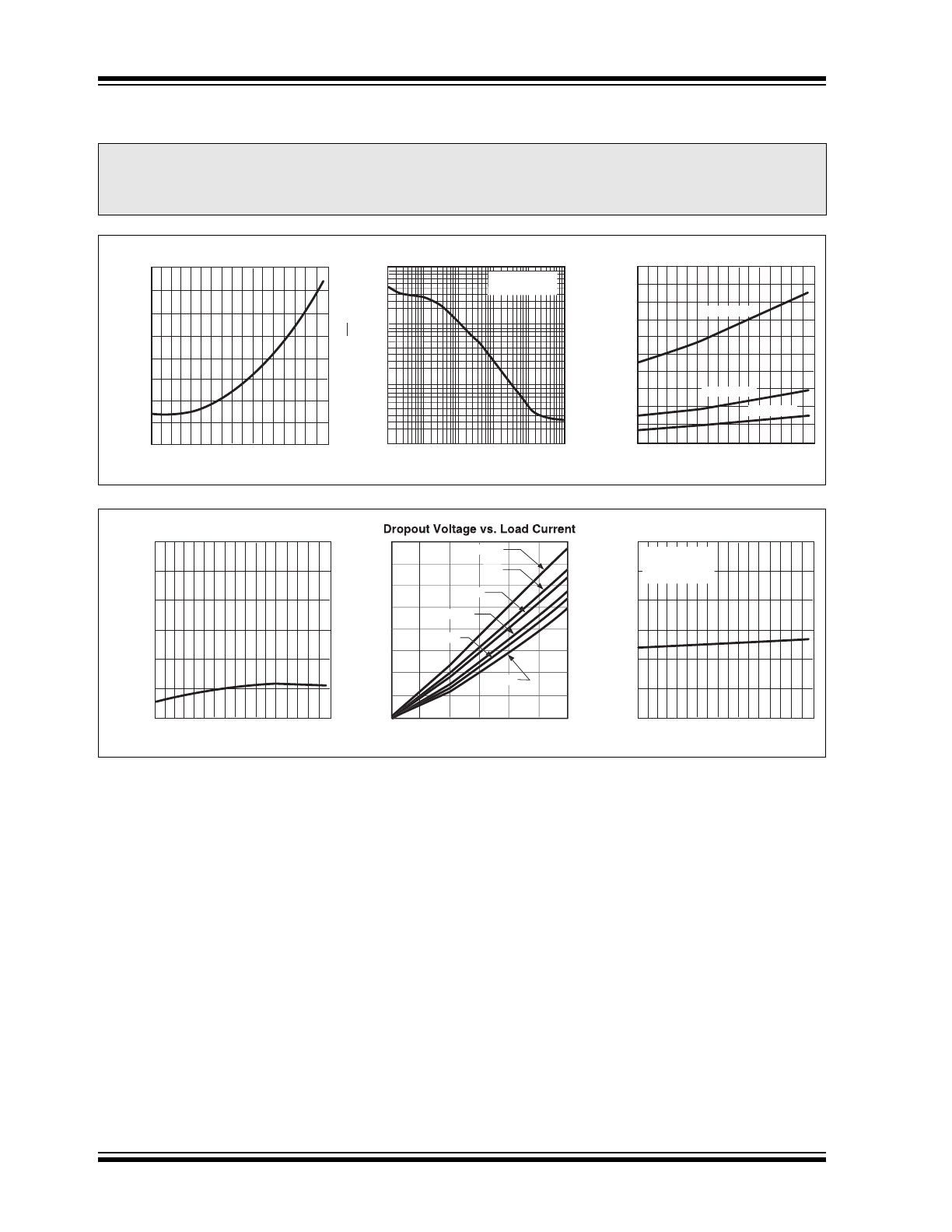
TC1173
DS21362C-page 6
2002-2012 Microchip Technology Inc.
5.0
TYPICAL CHARACTERISTICS
Note:
The graphs and tables provided following this note are a statistical summary based on a limited number of
samples and are provided for informational purposes only. The performance characteristics listed herein are
not tested or guaranteed. In some graphs or tables, the data presented may be outside the specified
operating range (e.g., outside specified power supply range) and therefore outside the warranted range.
Output Noise
FREQUENCY (kHz)
NOISE (
μ
V/
√
HZ)
10.0
1.0
0.01
0.01
1
10
100
1000
0.1
0.0
R
LOAD
= 50Ω
C
OUT
= 1
μF
0.012
0.010
0.008
0.004
0.002
0.000
-0.002
-0.004
0.006
-40
° -20° 0° 20° 40° 60° 80° 100° 120°
TEMPERATURE (
°
C)
Line Regulation
LINE REGULATION (%)
2.00
1.80
1.60
1.20
1.00
0.80
0.60
0.40
0.20
0.00
1.40
-40
° -20° 0° 20° 40° 60° 80° 100° 120°
TEMPERATURE (
°
C)
Load Regulation
LOAD REGULATION (%)
1 to 300mA
1 to 50mA
1 to 100mA
0.40
0.35
0.30
0.25
0.20
0.15
0.10
0.05
0.00
0
50
100
150
200
250
300
LOAD CURRENT (mA)
DROPOUT VOLTAGE (V)
100.0
90.0
70.0
80.0
50.0
40.0
60.0
-40
° -20° 0° 20° 40° 60° 80° 100° 120°
TEMPERATURE (
°C)
Supply Current
SUPPLY CURRENT (
μ
A)
3.075
3.025
2.925
2.975
-40
° -20° 0° 20° 40° 60° 80° 100° 120°
TEMPERATURE (
°C)
V
OUT
vs. Temperature
V
OUT
(V)
125
°C
8
85
°C
C
70
°C
25
°C
0
°C
C
-40
°C
V
IN
= 4V
I
LOAD
= 100μA
C
LOAD
= 3.3
μF
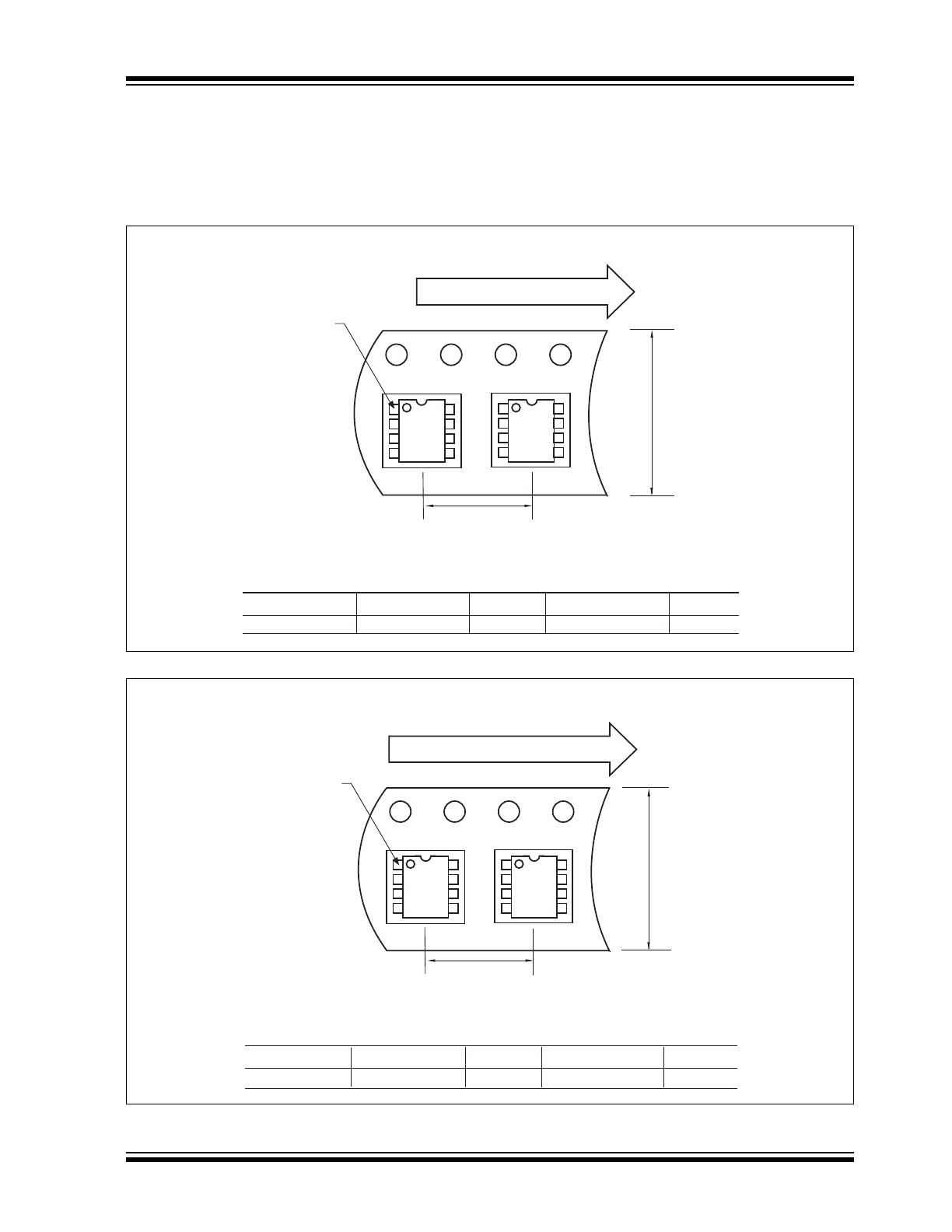
2002-2012 Microchip Technology Inc.
DS21362C-page 7
TC1173
6.0
PACKAGING INFORMATION
6.1
Package Marking Information
Package marking data not available at this time.
6.2
Taping Form
Component Taping Orientation for 8-Pin MSOP Devices
Package
Carrier Width (W)
Pitch (P)
Part Per Full Reel
Reel Size
8-Pin MSOP
12 mm
8 mm
2500
13 in
Carrier Tape, Number of Components Per Reel and Reel Size
PIN 1
User Direction of Feed
Standard Reel Component Orientation
for TR Suffix Device
W
P
Component Taping Orientation for 8-Pin SOIC (Narrow) Devices
Package
Carrier Width (W)
Pitch (P)
Part Per Full Reel
Reel Size
8-Pin SOIC (N)
12 mm
8 mm
2500
13 in
Carrier Tape, Number of Components Per Reel and Reel Size
Standard Reel Component Orientation
for TR Suffix Device
PIN 1
User Direction of Feed
P
W

TC1173
DS21362C-page 8
2002-2012 Microchip Technology Inc.
6.3
Package Dimensions
8-Pin MSOP
.122 (3.10)
.114 (2.90)
.122 (3.10)
.114 (2.90)
.043 (1.10)
MAX.
.006 (0.15)
.002 (0.05)
.016 (0.40)
.010 (0.25)
.197 (5.00)
.189 (4.80)
.008 (0.20)
.005 (0.13)
.028 (0.70)
.016 (0.40)
6
° MAX.
.026 (0.65) TYP.
PIN 1
Dimensions: inches (mm)
Note:
For the most current package drawings, please see the Microchip Packaging Specification located
at http://www.microchip.com/packaging
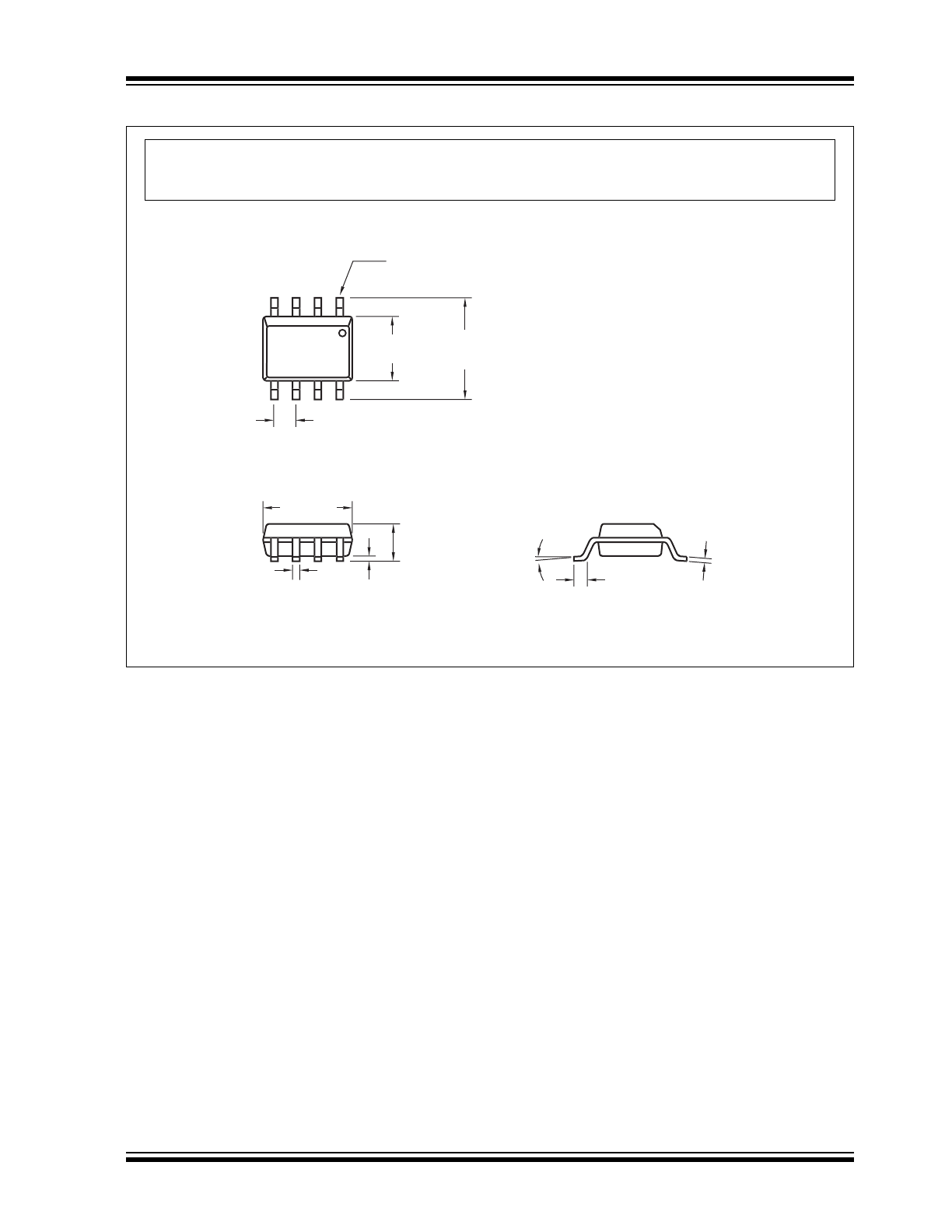
2002-2012 Microchip Technology Inc.
DS21362C-page 9
TC1173
.050 (1.27) TYP.
8
°
MAX.
PIN 1
.244 (6.20)
.228 (5.79)
.157 (3.99)
.150 (3.81)
.197 (5.00)
.189 (4.80)
.020 (0.51)
.013 (0.33)
.010 (0.25)
.004 (0.10)
.069 (1.75)
.053 (1.35)
.010 (0.25)
.007 (0.18)
.050 (1.27)
.016 (0.40)
.
8-Pin SOIC
Dimensions: inches (mm)
Note:
For the most current package drawings, please see the Microchip Packaging Specification located
at http://www.microchip.com/packaging

TC1173
DS21362C-page 10
2002-2012 Microchip Technology Inc.
REVISION HISTORY
Revision C (November 2012)
Added a note to each package outline drawing.
